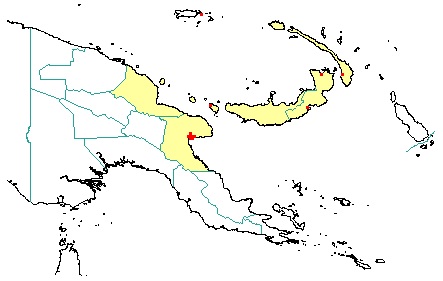
in PNGplants database
PNGTreesKey – Viticipremna novaepommeraniae (Warb.) H.J.Lam |
Barry Conn (NSW) & Kipiro Damas (LAE).
Guide to trees of Papua New Guinea
Copyright held by the authors, National Herbarium of New South Wales, and Papua New Guinea National Herbarium
Verbenac. Mal. Arch. 163 (1919)
Other Literature: A.A. Munir, Journal of the Adelaide Botanic Gardens 196-199 (1985) Fig. 5.
Family: Lamiaceae
Dicotyledon
Timber Group: Non-timber species
Field Characters: Small sub-canopy tree or Large canopy tree (mostly up to 27 m high, rarely to 34 m); Bole cylindrical (mostly up to 80 cm diam., rarely up to 120 cm); straight (bole up to c. 15 m long); buttresses buttresses absent; spines spines absent; aerial roots aerial roots absent; stilt roots stilt roots absent; Bark pale brown, rough, peeling; Subrhytidome (under-bark) white, yellow (pale (cream-coloured), or brown; less than 25 mm thick; bark blaze consisting of one layer; faintly to non-aromatic; outer blaze pale brown, pale yellow, or white, with stripes (orange); inner blaze white, pale yellow, or pale brown, with stripes (orange); bark exudate (sap) absent; terminal buds not enclosed by leaves.
Indumentum: Complex hairs absent; stinging hairs absent; mature twig indumentum (hairs) present, hairs dense (minutely hairy with rusty red-coloured hairs).
Leaves: Leaves spaced along branches, opposite (in pairs, opposite one another on the branchlet), compound (a leaf made up from two or more leaflets); petiole present, not winged, attached to base of leaf blade, not swollen; leaves palmate (with more than three leaflets attached at one point to the stalk) (usually with 4 or 5 leaflets) or rarely with three leaflets (trifoliate); petiolule not swollen; leaves broadest at or near middle or broadest above middle, (4.0-) 6.0-13.0 (-18.0) cm, (2.5-) 3.5-5.5 (-9.0) cm, leaflets arranged from one point, asymmetric; venation pinnate, secondary veins open, prominent, intramarginal veins absent; leaves lower surface pale green, upper surface green (glossy), indumentum (hairs) present, indumentum (hairs) sparse (particualrly on upper surface) or dense (along veins of lower surface); present (densely glandular, particularly on lower surface); domatia absent; stipules absent.
Flowers: Inflorescence terminal, flowers on a branched axis, cones absent; flowers bisexual, stalked, flowers with one plane of symmetry, 9.0-12.0 mm long, diameter small (up to10 mm diam.) (c. 5 mm diam.); perianth present, with distinct sepals and petals whorls (calyx truncate, not lobed), inner perianth white or mauve (markings); 4, some or partly joined; stamens 4, present, free of each other, joined to the perianth; ovary superior, carpels joined (when more than one), locules 4 (often appearing to be 2-locular); styles solitary, 1.
Fruits: Infrutescence arranged on branched axis, fruit 5.0-9.0 mm long, 5.0-8.0 mm diam., black or purple, not spiny, fleshy, simple, indehiscent, drupe; seeds 4, to about 5 mm long, not winged, narrow (longer than wide), seed 1-10 mm diam. (c. 3 mm diam.).
Distribution: Madang, Morobe, New Britain & New Ireland.
 | Botanical records in PNGplants database |
Notes: Notes This species has been frequently misidentified as Vitex quinata. Viticipremna novaepommeraniae has leaflets which are unequally obtuse or subtruncate at base; calyx truncate; corolla 4-lobed; carpels 4-locular, but often appearing 2-locular; ovary, non-glandular. However, Vitex quinata has leaflets which are symmetrical at base; calyx minutely 5-lobed; corolla 5-lobed; carpels 4-locular,but often appearing 2-locular; ovary glandular.
Viticipremna has been previously classified in the family Verbenaceae. It is now placed in the Lamiaceae subfamily Viticoideae.